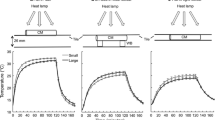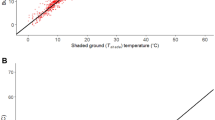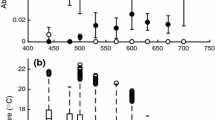Abstract
Ectotherms from low-temperature environments have higher metabolic rates at low temperatures than those from warm-temperature environments. We predicted that nocturnal lizards, which are active at much lower environmental temperatures than diurnal lizards, would also have higher metabolic rates at low temperatures, and by association a lower thermal sensitivity (Q 10) than diurnal and crepuscular lizards. We measured the rate of oxygen consumption (\( \dot{V}{\text{O}}_{ 2} \)) of eight cool-temperate species of lizard (four nocturnal, three diurnal, and one crepuscular) at 13 and 26°C and analyzed log transformations of these data using log mass as a covariate. As expected, \( \dot{V}{\text{O}}_{ 2} \) was positively correlated with temperature in all eight species, with \( \dot{V}{\text{O}}_{ 2} \) being two to four times higher at 26°C than at 13°C. As predicted, at 13°C (but not 26°C) the \( \dot{V}{\text{O}}_{ 2} \) was significantly higher in nocturnal than diurnal lizards. Species-specific differences and mass scaling factors explain the patterns of thermal sensitivity seen among these eight lizard species. Thermal sensitivity is strongly influenced by mass, with smaller species generally having higher thermal sensitivity of their metabolic rate, and this result deserves further exploration among other ectotherms. We conclude that, along with the previously reported lower cost of locomotion found in nocturnal lizards, they also partially offset the thermal handicap of activity at low body temperatures by having an elevated \( \dot{V}{\text{O}}_{ 2} \) at lower temperatures.


Similar content being viewed by others
References
Addo-Bediako A, Chown SL, Gaston KJ (2002) Metabolic cold adaptation in insects: a large-scale perspective. Funct Ecol 16:332–338
Aleksiuk M (1971) Temperature-dependent shifts in the metabolism of a cool temperate reptile, Thamnophis sirtalis parietalis. Comp Biochem Physiol A 39:495–503
Andrews RM, Pough FH (1985) Metabolism of squamate reptiles: allometric and ecological relationships. Physiol Zool 58:214–231
Autumn K (1999) Secondarily diurnal geckos return to cost of locomotion typical of diurnal lizards. Physiol Biochem Zool 72:339–351
Autumn K, Weinstein RB, Full RJ (1994) Low cost of locomotion increases performance at low temperature in a nocturnal lizard. Physiol Zool 67:238–262
Autumn K, Farley CT, Emshwiller M, Full RJ (1997) Low cost of locomotion in the banded gecko: a test of the nocturnality hypothesis. Physiol Zool 70:660–669
Autumn K, Jindrich D, DeNardo DF, Mueller R (1999) Locomotor performance at low temperature and the evolution of nocturnality in geckos. Evolution 53:580–599
Bennett AF (1982) The energetics of reptilian activity. In: Gans C, Pough FH (eds) Biology of the reptilia—physiology D. Academic Press, London, pp 155–199
Bennett AF, Dawson WR (1976) Metabolism. In: Gans C, Dawson WR (eds) Biology of the reptilia—physiology A. Academic Press, London, pp 127–223
Bennett AF, Harvey PH (1987) Active and resting metabolism in birds: allometry, phylogeny and ecology. J Zool 213:327–363
Bennett AF, John-Alder HB (1984) The effect of body temperature on the locomotory energetics of lizards. J Comp Physiol B 155:21–27
Chapple DG, Ritchie PA, Daugherty CH (2009) Origin, diversification, and systematics of the New Zealand skink fauna (Reptilia: Scincidae). Mol Phylo Evol 522:470–487
Cree A (1994) Low annual reproductive output in female reptiles from New Zealand. N Z J Zool 21:351–372
Daan S, Masman D, Groenewold A (1990) Avian basal metabolic rates: their association with body composition and energy expenditure in nature. Am J Physiol 259:R333–R340
Deeming DC (2004) Reptilian incubation: environment, evolution and behaviour. Nottingham University Press, Nottingham
Farley CT, Emshwiller M (1996) Efficiency of uphill locomotion in nocturnal and diurnal lizards. J Exp Biol 199:587–592
Feder ME, Feder JH (1981) Diel variation of oxygen consumption in three species of Philippine gekkonid lizards. Copeia 1981:204–209
Garland TJ (1992) Rate tests for phenotypic evolution using phylogenetically independent contrasts. Am Nat 140:509–519
Gentleman R, Ihaka R, Leisch F (2003) R: a language and environment for statistical computing, Vienna, Austria
Gill W, Whitaker T (2001) New Zealand frogs and reptiles. David Bateman Limited, Auckland
Grimmond NM, Evetts PM (1980) The effects of temperature on heat exchange and oxygen consumption in two sympatric New Zealand lizards. In: Szelényi Z, Székely M (eds) Advances in Physiological Sciences, Contributions to Thermal Physiology. Satellite Symposium of the 28th International Congress of Physiological Sciences. Pecs, Hungary. Akademiai Kiado, Budapest, Hungary, pp 257–259
Han D, Zhou K, Bauer AM (2004) Phylogenetic relationships among gekkotan lizards inferred from C-mos nuclear DNA sequences and a new classification of the Gekkota. Biol J Linn Soc 83:353–368
Hare KM (2007) Hoplodactylus chrysosireticus (Goldstripe gecko). Body temperature. Herpetol Rev 38:456–457
Hare KM, Pledger S, Thompson MB, Miller JH, Daugherty CH (2004) Conditioning reduces metabolic rate and time to steady-state in the lizard Naultinus manukanus (Reptilia: Gekkonidae). Comp Biochem Physiol A 139:245–250
Hare KM, Miller JH, Clark A, Daugherty CH (2005) Total lactate dehydrogenase activity of tail muscle is not cold-adapted in nocturnal lizards from cool-temperate habitats. Comp Biochem Physiol B 142:438–444
Hare KM, Pledger S, Thompson MB, Miller JH, Daugherty CH (2006) Daily patterns of metabolic rate among New Zealand lizards (Reptilia: Lacertilia: Diplodactylidae & Scincidae). Physiol Biochem Zool 79:745–753
Hare KM, Pledger S, Thompson MB, Miller JH, Daugherty CH (2007) Low cost of locomotion in lizards that are active at low temperatures. Physiol Biochem Zool 80:46–58
Harvey PH, Pagel MD (1991) The comparative method in evolutionary biology. Oxford University Press, Oxford
Hitchmough RA (1997) A systematic revision of the New Zealand Gekkonidae. School of Biological Sciences. Victoria University of Wellington, Wellington, p 369
Hochachka PW, Somero GN (2002) Biochemical adaptation: mechanism and process in physiological evolution. Oxford University Press, New York
Hopkins WA, Roe JH, Philippi T, Congdon JD (2004) Standard and digestive metabolism in the banded water snake, Nerodia fasciata fasciata. Comp Biochem Physiol A 137:141–149
Huey RB, Kingsolver JG (1989) Evolution of thermal sensitivity of ectotherm performance. TREE 4:131–135
Huey RB, Niewiarowski PH, Kaufmann J, Herron JC (1989) Thermal biology of nocturnal ectotherms: is sprint performance of geckos maximal at low body temperatures? Physiol Zool 62:488–504
Kearney M, Predavec M (2000) Do nocturnal ectotherms thermoregulate? A study of the temperate gecko Christinus marmoratus. Ecology 81:2984–2996
Lawrence M (1997) The effect of temperature on the eating behaviour, gut passage times, and digestion efficiency of lizards. N Z J Zool 24:328
Long SP, Ireland CR (1985) The measurement and control of air and gas flow rates for the determination of gaseous exchanges of living organisms. In: Marshall B, Woodward FI (eds) Instrumentation for environmental physiology. Cambridge University Press, Cambridge, pp 123–137
Lovegrove BG (2003) The influence of climate on the basal metabolic rate of small mammals: a slow–fast metabolic continuum. J Comp Physiol B 173:87–112
Manly BFJ (1997) Randomization, bootstrap and Monte Carlo methods in biology. Chapman & Hall, London
Martins EP, Garland TJ (1991) Phylogenetic analyses of the correlated evolution of continuous characters: a simulation study. Evolution 45:534–557
Mautz WJ (1979) The metabolism of reclusive lizards, the Xantusiidae. Copeia 1979:577–584
Mondal S, Rai U (2001) In vitro effect of temperature on phagocytic and cytotoxic activities of splenic phagocytes of the wall lizard, Hemidactylus flaviviridis. Comp Biochem Physiol A 129:391–398
Naya DE, Veloso C, Muñoz JLP, Bozinovic F (2007) Some vaguely explored (but not trivial) costs of tail autotomy in lizards. Comp Biochem Physiol A 146:189–193
Neilson KA (2002) Evaporative water loss as a restriction on habitat use in endangered New Zealand endemic skinks. J Herpetol 36:342–348
Packard GC, Boardman TJ (1988) The misuse of ratios, indices, and percentages in ecophysiological research. Physiol Zool 61:1–9
Pagel MD, Harvey PH (1988) Recent developments in the analysis of comparative data. Q Rev Biol 63:413–440
Pough FH (1980) The advantages of ectothermy for tetrapods. Am Nat 115:92–112
Preest MR (1985) Some aspects of the metabolism of the Otago giant skinks, Leolopisma grande (Gray 1845) Leiolopisma otagense form otagense (McCann 1955) and Leiolopisma otagense form waimatense (Hardy 1977). University of Otago, Dunedin, p 106
Preest MR, Cree A (2008) Corticosterone treatment has subtle effects on thermoregulatory behavior and raises metabolic rate in the New Zealand common gecko, Hoplodactylus maculatus. Physiol Biochem Zool 81:641–650
R-Development-Core-Team (2008) R: a language and environment for statistical computing. R Foundation for Statistical Computing, Vienna
Robert KA, Thompson MB (2000) Influence of feeding on the metabolic rate of the lizard, Eulamprus tympanum. Copeia 2000:851–855
Rock J (2006) Delayed parturition: constraint or coping mechanism in a viviparous gekkonid? J Zool 268:355–360
Rock J, Cree A, Andrews RM (2002) The effect of reproductive condition on thermoregulation in a viviparous gecko from a cool climate. J Therm Biol 27:17–27
Rogers KD, Thompson MB, Seebacher F (2007) Beneficial acclimation: sex specific thermal acclimation of metabolic capacity in the striped marsh frog (Limnodynastes peronii). J Exp Biol 210:2932–2939
Seebacher F, Grigg GC, Beard LA (1999) Crocodiles as dinosaurs: behavioural thermoregulation in very large ectotherms leads to high and stable body temperatures. J Exp Biol 202:77–86
Steffensen JF (2002) Metabolic cold adaptation of polar fish based on measurements of aerobic oxygen consumption: fact or artefact? Artefact!. Comp Biochem Physiol A 132:789–795
ter Braak CJF (1992) Permutation versus bootstrap significance tests in multiple regression and ANOVA. In: Jöcke l KH (ed) Bootstrapping and related techniques. Springer, Berlin, pp 79–86
Tocher MD (1992) Paradoxical preferred body temperatures of two allopatric Hoplodactylus maculatus (Reptilia: Gekkonidae) populations from New Zealand. N Z Nat Sci 19:53–60
Van Damme R, Vanhooydonck B (2001) Origins of interspecific variation in lizard sprint capacity. Funct Ecol 15:186–202
Vitt LJ, Pianka ER, Cooper WE Jr, Schwenk K (2003) History and the global ecology of squamate reptiles. Am Nat 162:44–60
Waldschmidt SR, Jones SM, Porter WP (1987) Reptilia. In: Panadian TJ, Vernberg FJ (eds) Animal energetics. Academic Press, New York, pp 553–619
Werner YL, Whitaker AH (1978) Observations and comments on the body temperatures of some New Zealand reptiles. N Z J Zool 5:375–393
Withers P (1977) Measurement of VO2, and VCO2, and evaporative water loss with a flow-through mask. J Appl Physiol 42:120–123
Wodtke E (1981) Temperature adaptation of biological membranes. Compensation of the molar activity of cytochrome c oxidase in the mitochondrial energy-transducing membrane during thermal acclimation of the carp (Cyprinus carpio L.). Biochim Biophys Acta 640:710–720
Acknowledgments
Research was carried out with consultation with Ngāti Koata and Ngāti Toa people. We thank numerous field assistants for assisting with lizard capture. We also thank the Victoria University of Wellington (VUW) herpetological hatchet group, J. P. Hayes, G. C. Packard, and reviewers for comments on draft manuscripts. Financial support was provided by the Allan Wilson Centre for Molecular Ecology and Evolution, a VUW Postgraduate Scholarship, a New Zealand Federation for Graduate Women Fellowship, and a Foundation for Research Science and Technology Postdoctoral Research Fellowship to KMH and an Australian Research Council grant to MBT.
Author information
Authors and Affiliations
Corresponding author
Additional information
Communicated by I.D. Hume.
Rights and permissions
About this article
Cite this article
Hare, K.M., Pledger, S., Thompson, M.B. et al. Nocturnal lizards from a cool-temperate environment have high metabolic rates at low temperatures. J Comp Physiol B 180, 1173–1181 (2010). https://doi.org/10.1007/s00360-010-0489-3
Received:
Revised:
Accepted:
Published:
Issue Date:
DOI: https://doi.org/10.1007/s00360-010-0489-3




